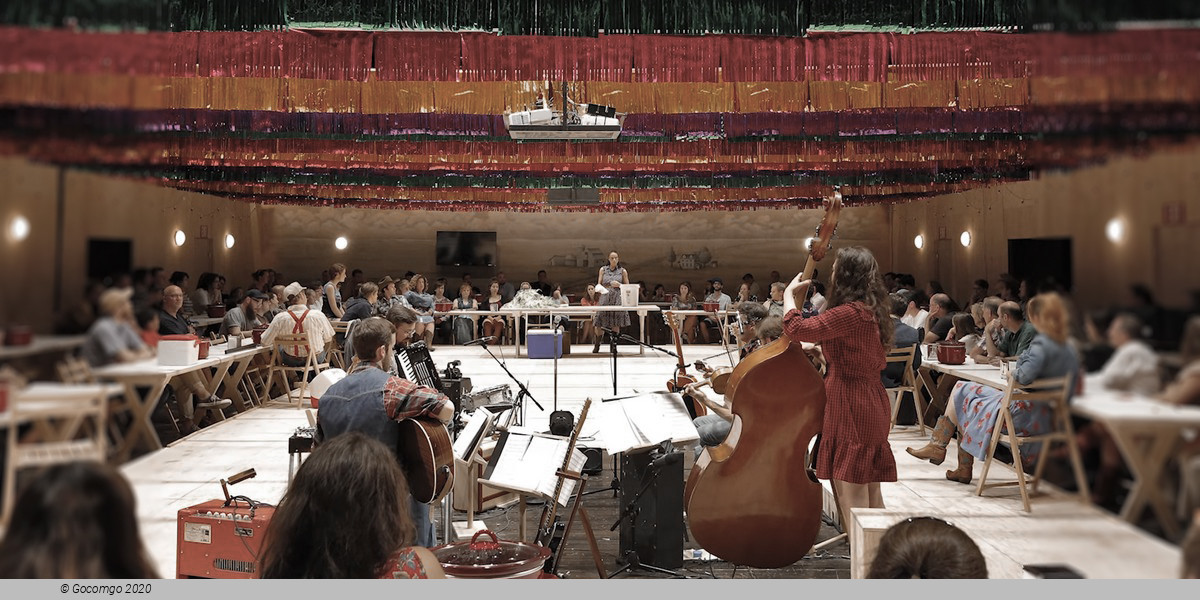Circle in the Square Theatre (New York, USA)
Circle in the Square Theatre

The Circle in the Square Theatre is a Broadway theater at 235 West 50th Street, in the basement of Paramount Plaza, in the Midtown Manhattan neighborhood of New York City. It is one of two Broadway theaters that use a thrust stage that extends into the audience on three sides.
The original Circle in the Square was founded by Theodore Mann, José Quintero, Jason Wingreen, Aileen Cramer and Emily Stevens in 1951 and was located at 5 Sheridan Square (a former nightclub) in Greenwich Village. The original Circle in the Square did not have a theater license, but Mann was able to get a cabaret license; the production staff and off duty actors served as waiters if anyone insisted on ordering food or drinks. Many of the theater personnel, both acting and technical, lived on the premises. Even classical performances took place here: Pianist Grete Sultan, who later became a well-known interpreter of New Music and was John Cage's close friend, performed the Goldberg Variations by Johann Sebastian Bach at the theatre in January 1953. After directing several landmark productions at Circle in the Square, Jose Quintero left to work on other projects. His last production for Circle in the Square was Eugene O'Neill's Desire Under The Elms.The best known productions in the original theater were Tennessee Williams's Summer and Smoke, with Geraldine Page and Eugene O'Neill's The Iceman Cometh, with Jason Robards.
In 1960, the company moved to the Circle in the Square Downtown, at 159 Bleecker Street in Greenwich Village in a historic building built in 1917 (which now houses The Market NYC, an indoor market). Its first production in the new space was Thornton Wilder's Our Town. Before it became the second Circle in the Square Theatre, the company's new home was first a movie house followed by the original Amato Opera House. It was built by and operated by Italian-Americans, which was typical of the South Village in the late-19th/early -20th centuries. Many of these theaters in the South Village were, like the second Circle in the Square, built or altered from other types of existing structures. This location allowed productions to be staged in a theater in the round format, with a long jutting stage flanked by seats on both sides.
In 1963, Theodore Mann invited Paul Libin to join the Circle in the Square as its managing director.
Designed by architect Alan Sayles, the present home of the company is in the basement of the Paramount Plaza office tower. It is one of Paramount Plaza's two theaters, the other being the much larger Gershwin Theatre on the second floor. The theatre entrance lobbies are side by side but separated by a wall. It is designed to reflect the theatres of ancient Greece and Rome and is the only Broadway theatre that has a vomitorium, which is sometimes used as an entrance and exit for the actors.
The Gershwin and Circle in the Square were built in 1970 when the Uris Brothers tore down the Capitol Theatre to build the tower (with the Gershwin originally being called the Uris Theatre). Their first production on Broadway, a revival of Mourning Becomes Electra, opened on November 15, 1972. The theatre is below street level. It is one of only two Broadway houses with a thrust stage (the other is Lincoln Center's Vivian Beaumont Theater).
The theatre operated as a non-profit, subscription-supported producing house for the next 25 years, but after a series of poor critical and financial returns, the company filed for bankruptcy in 1997. The theatre reopened in 1999, now operating as an independent commercial receiving house. Profits from the operation of the theatre are used to support the Circle in the Square Theatre School, the only accredited training conservatory associated with a Broadway theatre, which offers two two-year training programs in acting and musical theatre, and is located at the theatre.


